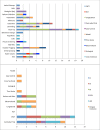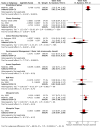Is Dengue Vector Control Deficient in Effectiveness or Evidence?: Systematic Review and Meta-analysis
- PMID: 26986468
- PMCID: PMC4795802
- DOI: 10.1371/journal.pntd.0004551
Is Dengue Vector Control Deficient in Effectiveness or Evidence?: Systematic Review and Meta-analysis
Abstract
Background: Although a vaccine could be available as early as 2016, vector control remains the primary approach used to prevent dengue, the most common and widespread arbovirus of humans worldwide. We reviewed the evidence for effectiveness of vector control methods in reducing its transmission.
Methodology/principal findings: Studies of any design published since 1980 were included if they evaluated method(s) targeting Aedes aegypti or Ae. albopictus for at least 3 months. Primary outcome was dengue incidence. Following Cochrane and PRISMA Group guidelines, database searches yielded 960 reports, and 41 were eligible for inclusion, with 19 providing data for meta-analysis. Study duration ranged from 5 months to 10 years. Studies evaluating multiple tools/approaches (23 records) were more common than single methods, while environmental management was the most common method (19 studies). Only 9/41 reports were randomized controlled trials (RCTs). Two out of 19 studies evaluating dengue incidence were RCTs, and neither reported any statistically significant impact. No RCTs evaluated effectiveness of insecticide space-spraying (fogging) against dengue. Based on meta-analyses, house screening significantly reduced dengue risk, OR 0.22 (95% CI 0.05-0.93, p = 0.04), as did combining community-based environmental management and water container covers, OR 0.22 (95% CI 0.15-0.32, p<0.0001). Indoor residual spraying (IRS) did not impact significantly on infection risk (OR 0.67; 95% CI 0.22-2.11; p = 0.50). Skin repellents, insecticide-treated bed nets or traps had no effect (p>0.5), but insecticide aerosols (OR 2.03; 95% CI 1.44-2.86) and mosquito coils (OR 1.44; 95% CI 1.09-1.91) were associated with higher dengue risk (p = 0.01). Although 23/41 studies examined the impact of insecticide-based tools, only 9 evaluated the insecticide susceptibility status of the target vector population during the study.
Conclusions/significance: This review and meta-analysis demonstrate the remarkable paucity of reliable evidence for the effectiveness of any dengue vector control method. Standardised studies of higher quality to evaluate and compare methods must be prioritised to optimise cost-effective dengue prevention.
Conflict of interest statement
The authors have declared that no competing interests exist.
Figures





References
-
- World Health Organization. Dengue and severe dengue, Factsheet No. 117. WHO. 2012. Available http://www.who.int/mediacentre/factsheets/fs117/en/. Accessed 1st July 2015.
-
- World Health Organization. Global strategy for dengue prevention and control 2012–2020 WHO; 2012. August:1–43.
Publication types
MeSH terms
Grants and funding
LinkOut - more resources
Full Text Sources
Other Literature Sources
Medical

